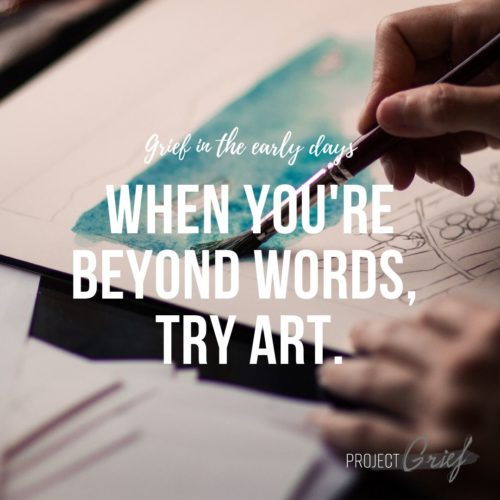When I was twelve years old, my dad passed away of a sudden heart attack. I struggled to understand and express my grief for many years afterward, and art was sometimes my only outlet for grief. I graduated in 2013 with a thesis on “Cultural Expressions of Grief Through Art,” which was published in an online journal that same year. Since then, I have spoken at multiple conferences nationwide and led grief art workshops throughout the Northwest. I am now a practicing artist, teacher and certified Therapeutic Art Life Coach. I created Project Grief so I could help others learn the power of art to heal after experiencing a loss.

- Start small
Grief in the early days is like facing a blank canvas. You likely had a beautiful painting in mind when it came to your life with your loved ones. In an instant, it was erased, leaving you facing the blankness of living life without them, devastated and beyond scared. The same things you feel when facing a blank canvas may come to your mind now, too. “Am I good enough to try this? What if I mess up? How do I even start?” When I’m overwhelmed by the blankness of a canvas, a loss or a new chapter of life, I always START SMALL.
In art: begin with a few brushstrokes and cover all the blank canvas with color! Cover it with one color, cover it with a messy rainbow of them all. It doesn’t matter, just cover the blank! It’s amazing how good it feels to simply start something. The next step in contemplating that painting is much easier because, in your mind, you know you’re already on your way to creating something beautiful.
In life after loss: start small — it’s the key to starting at all. Maybe you’ve retreated from relationships for a time because it was too much to handle. Maybe you stopped eating healthy and exercising because you were simply trying not to collapse in a puddle. DON’T make huge goals right now. Take things “low and slow”. A small start could be as simple as setting a half an hour coffee date with one friend next week. Whatever it is, start small. It’s a start, and you’ll be glad you did.
Art helps us create something beautiful out of the “blankness” that loss leaves in our lives. To learn more about art as a tool for grief recovery, visit Project Grief.

- Realize it’s a process
When grief feels too big and scary, you might find yourself in the fight or flight response. Grief is enormous. However, if we falsely assume we have to deal with it all at one time (or in X number of months), we place our emotional health on the losing side of the battle.
In reality, grief can be dealt with bit by bit and over a long period of time. There are so many overwhelming tasks when you face a loss: cleaning out an old house or closet, an endless string of phone calls, etc., when all you want to do is curl up in a ball. These tasks do need to get done but not all today. So tackle them a little bit at a time. Conquering a small to-do item or even a fraction of one to-do item every day gives you a small “win” that will accumulate into a larger one.
Blank canvases are handed to us in an instant. The real work comes in making something beautiful out of the blank. Any work of art is completed over a long period of time. Artists are notorious for working sporadically — why would it be any different for you?
Art helps us create something beautiful out of the “blankness” that loss leaves in our lives. To learn more about art as a tool for grief recovery, visit Project Grief.

- When you’re beyond words, try art.
Grief in the early days is an endless barrage of words. Your words try to explain what happened; your words try to answer the barrage of “How are you doing, honey?”; your words falter when you need them and get angry when you don’t. Because grief takes us beyond words, you might actually find it easy to pick up art as a method of expression during this difficult time. A simple prompt to “draw how you feel” might be intimidating at first. But instead, pick up a red crayon and a black crayon and scribble circles on a page until it’s covered. Didn’t you just express something profound with that small, simple action?
You don’t need to be an artist in order to experience the benefits of using art in your grief journey. Fine art (what people usually think of when they say “I’m not an artist”) is all about the product. Grief art, on the other hand, is all about the process of creating it. It might produce a result that’s less than aesthetically pleasing, but know what? Grief isn’t pretty, either.
There’s another benefit to be had here as well. The meaning you put onto your canvas is carried on — it speaks for itself. The next time someone asks, “How are you doing?”, try showing them a piece of art you create. You might need to explain it a bit, but chances are they’ll know exactly what you mean.
Art helps you deal with overwhelming feelings in a small, safe space. To learn more about art as a tool for grief recovery, visit Project Grief.





